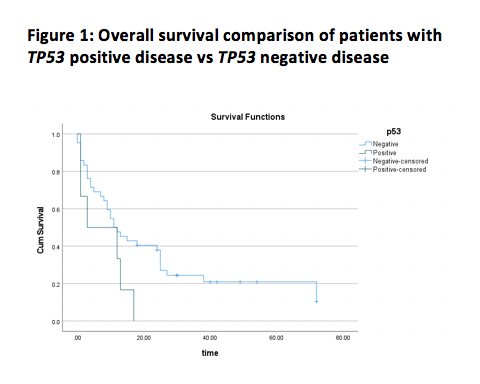
Contributions
Abstract: PB1412
Type: Publication Only
Session title: Acute myeloid leukemia - Clinical
Background
Acute myeloid leukaemia (AML) is a heterogenous disorder that arises from clonal expansion of malignant haematopoetic precursor cells. Somatic mutations of the tumour suppressor p53 gene have been reported in 5-10% of all patients with AML, although the incidence is higher in therapy-related disease and elderly patients. Alteration or loss of the p53 gene is one of the most powerful independent indicators of poor outcome. Overexpression of the BCL2 proto-oncogene in AML is less well described in the literature and its impact on prognosis is uncertain.
Aims
This is a single-centre, retrospective analysis of AML patients treated over a ten year period (2006-2016).
Methods
Patients were identified through our pathology database. p53 expression was analysed as a surrogate marker for TP53 mutation, as was BCL2 expression, by immunohistochemical analysis of marrow trephine biopsies. We analysed presentation, management and overall survival (OS) of AML patients, and correlated these with p53 mutational status and with BCL2 expression.
Results
We identified 48 patients with AML; the majority were male (60%) and the median age at diagnosis was 68.5 years (range 37-85). Thirty-four patients (71%) had denovo presentation of AML. p53 overexpression was identified in 6 patients (12.5%), of whom 3 had secondary AML, and 3 had denovo presentations. BCL2expression analysis showed a median value of 60% (range 5-100%). BCL2 positivity was seen in 39 patients (81.2%).
Thirty-nine patients (83%) received active treatment; the remainder received only supportive care due either to frailty or patient choice. Nineteen patients (49%) of patients subsequently had relapsed/refractory disease. Five patients (13.5%) with BCL2 overexpression at diagnosis received Venetoclax as single agent, either as 2nd or 3rd line therapy.
Median OS was 11.5 months (range 0-72); at time of follow-up, 39 patients (81%) had died. Twenty-six patients died from disease progression (79%) and 7 (19%) of sepsis; in 2% the cause of death was unknown. OS in those with wild-type p53 was 11.5 months, which compared favourably to 7.5 months in those with p53 overexpression. BCL2 overexpression also conferred a poorer prognosis; median OS was 10 months compared to 17 months in BCL2 negative disease.

Conclusion
This study reflects real-life practice in treating AML patients outside of a clinical trial context. It demonstrates a slightly higher prevalence of p53 mutation in the elderly, and confirmed the previously reported poor prognosis of p53 alterations in AML (OS 7.5 months). It also demonstrates poorer OS in disease with BCL2overexpression. Further studies are needed to identify treatment strategies to overcome both p53 and BCL2 disruption in AML.
Keyword(s): AML, BCL2, P53
Abstract: PB1412
Type: Publication Only
Session title: Acute myeloid leukemia - Clinical
Background
Acute myeloid leukaemia (AML) is a heterogenous disorder that arises from clonal expansion of malignant haematopoetic precursor cells. Somatic mutations of the tumour suppressor p53 gene have been reported in 5-10% of all patients with AML, although the incidence is higher in therapy-related disease and elderly patients. Alteration or loss of the p53 gene is one of the most powerful independent indicators of poor outcome. Overexpression of the BCL2 proto-oncogene in AML is less well described in the literature and its impact on prognosis is uncertain.
Aims
This is a single-centre, retrospective analysis of AML patients treated over a ten year period (2006-2016).
Methods
Patients were identified through our pathology database. p53 expression was analysed as a surrogate marker for TP53 mutation, as was BCL2 expression, by immunohistochemical analysis of marrow trephine biopsies. We analysed presentation, management and overall survival (OS) of AML patients, and correlated these with p53 mutational status and with BCL2 expression.
Results
We identified 48 patients with AML; the majority were male (60%) and the median age at diagnosis was 68.5 years (range 37-85). Thirty-four patients (71%) had denovo presentation of AML. p53 overexpression was identified in 6 patients (12.5%), of whom 3 had secondary AML, and 3 had denovo presentations. BCL2expression analysis showed a median value of 60% (range 5-100%). BCL2 positivity was seen in 39 patients (81.2%).
Thirty-nine patients (83%) received active treatment; the remainder received only supportive care due either to frailty or patient choice. Nineteen patients (49%) of patients subsequently had relapsed/refractory disease. Five patients (13.5%) with BCL2 overexpression at diagnosis received Venetoclax as single agent, either as 2nd or 3rd line therapy.
Median OS was 11.5 months (range 0-72); at time of follow-up, 39 patients (81%) had died. Twenty-six patients died from disease progression (79%) and 7 (19%) of sepsis; in 2% the cause of death was unknown. OS in those with wild-type p53 was 11.5 months, which compared favourably to 7.5 months in those with p53 overexpression. BCL2 overexpression also conferred a poorer prognosis; median OS was 10 months compared to 17 months in BCL2 negative disease.

Conclusion
This study reflects real-life practice in treating AML patients outside of a clinical trial context. It demonstrates a slightly higher prevalence of p53 mutation in the elderly, and confirmed the previously reported poor prognosis of p53 alterations in AML (OS 7.5 months). It also demonstrates poorer OS in disease with BCL2overexpression. Further studies are needed to identify treatment strategies to overcome both p53 and BCL2 disruption in AML.
Keyword(s): AML, BCL2, P53


